|
The International Style
International style or Bauhause style
1920-1945
The International style debuted in 1932 at the Museum of Modern Art in New York City. Between WWI and WWII Americans concentrated on revival architecture while European designers took architecture in an entirely new direction which became known as the International style. Like Art Modern, the International style, also known as the Bauhause style(bauen-to build/ haus-house) emphasizes the horizontal but rejects all decorative elements and functionalism.
By the late 1920s, American architects were persuaded that European modernism was progressive and structurally sound. This style epitomizes the height of the modern movement in the United States and Europe. The So-called " glass boxes".
Defining features:
• Simple geometric forms, often rectilinear
• Asymmetrical
• concrete and steel construction
• a cantilevered upper floor or balcony
• Flat roof, without an eave or ledge
• flush, metal ribbon windows.
• Casement windows; sliding windows
• Doorway treatments conspicuously plain, lacking decorative detailing
• Corner windows a hallmark of the style
• Modern structural principles and materials-concrete, glass, steel the most common
• Sometimes a skeleton-frame construction, exposing its structure
• No non-essential decoration
• Metal mullions and smooth spandrel panels separating large, single-pane windows.
International (1950-1980)
The International style was almost excusively used for commercial and institutional buildings through the 1930s. After WWII the style resurfaced during the building boom of 1948-1949.
Commercial architecture became an important form of corporate image and expression and the International style was used extensively throughout the world in large and small cities. The World Trade Center towers represented the height of the International-style office tower of the 1970s.
The style endeavored to complement the machine age with a modern, artistic expression. The International style completely dominated American commercial architecture from the 1950s through the late 1970s.
|





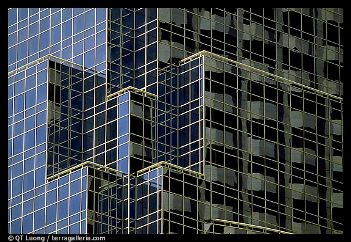

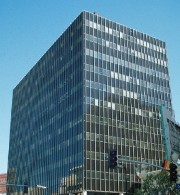
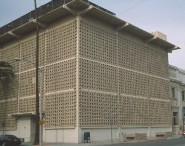
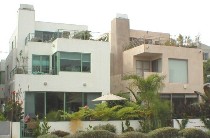 • Complete absence of ornamentation and decoration; often, an entire blank wall
• Complete absence of ornamentation and decoration; often, an entire blank wall 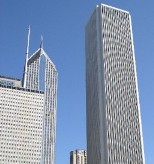 • Large areas of floor-to-ceiling glass or curtain walls of glass
• Large areas of floor-to-ceiling glass or curtain walls of glass 

